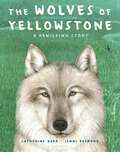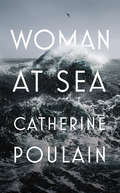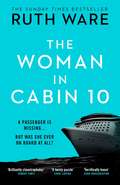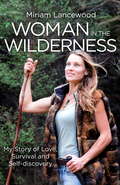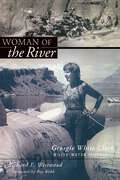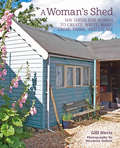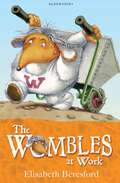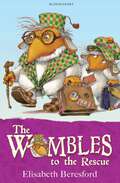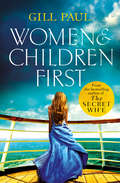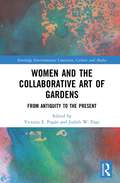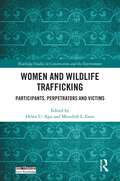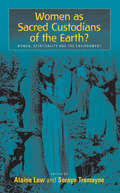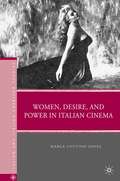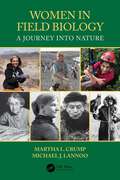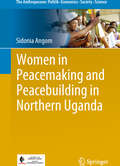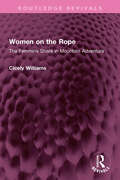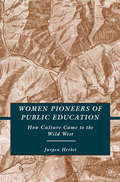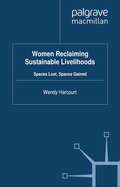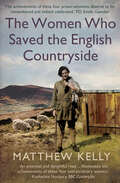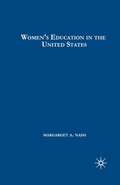- Table View
- List View
The Wolves of Yellowstone: A Rewilding Story
by Catherine BarrHere is the fascinating true story of the wolves who restored the ecosystem at Yellowstone National Park, written by Catherine Barr and illustrated by award-winner Jenni Desmond.In the 1930s, the last wolves disappeared from Yellowstone National Park. Without them, elk herds overran the plains. Bears starved, rabbit families shrunk, and birds flew away to new homes. Then plants and trees started to die off, too-even the flow of rivers was affected. Could the park be saved . . . by the wolves it had lost? After years of planning, in 1995 a team of experts was ready to find out. They carefully relocated fourteen wolves from the Canadian Rockies to Yellowstone. This is the story of their homecoming.Engaging, informative, and hopeful, The Wolves of Yellowstone shows us that every creature plays a role in sustaining a thriving ecosystem.
Woman at Sea
by Catherine Poulain Adriana Hunter'A tale of travel and adventure, the story of a body utterly surrendered to pain and joy. It is mind-blowing, a delight.' Le MondeLili is a runaway. She’s left behind her native France to go in search of freedom, of adventure, of life. Her search takes her to Kodiak, Alaska, home to a ragtag community of fishermen, army vets and drifters who man the island’s fishing fleet. Despite her tiny frame, faltering English and lack of experience, Lili lands a job on board the Rebel, the only woman on the boat.Out on the open sea, everything is heightened: colours are more vivid, sounds are louder and the work is harder than anything she's ever known. The terrifying intensity of the ocean is addictive to the point of danger. But Lili is not alone: in her fellow crewmembers she finds kindred spirits – men living on the edge, drawn to extremes. Based on Catherine Poulain’s own experiences, and written in taut, muscular prose, Woman at Sea cuts through the noise of life and straight to the heart of our innermost longings.
The Woman in Cabin 10: The unputdownable thriller from the Sunday Times bestselling author of The IT Girl
by Ruth Ware'Reads like Agatha Christie got together with Paula Hawkins to crowdsource a really fun thriller' StylistA PASSENGER IS MISSING...BUT WAS SHE EVER ON BOARD AT ALL?This was meant to be the perfect trip. The Northern Lights. A luxury press launch on a boutique cruise ship.A chance for travel journalist Lo Blacklock to recover from a traumatic break-in that has left her on the verge of collapse.Except things don't go as planned.Woken in the night by screams, Lo rushes to her window to see a body thrown overboard from the next door cabin. But the records show that no-one ever checked into that cabin, and no passengers are missing from the boat.Exhausted and emotional, Lo has to face the fact that she may have made a mistake - either that, or she is now trapped on a boat with a murderer..._________________Praise for THE WOMAN IN CABIN 10:' Scary and unsettling, it's' edge-of-your-seat stuff' The Sun'A tense, moody drama set on a press trip that goes horribly wrong... a brilliantly claustrophobic setting' Sunday Times'A twisty puzzle' Shari Lapena'Terrifically tense' Good Housekeeping
Woman in the Wilderness: My Story of Love, Survival and Self-Discovery
by Miriam Lancewood'An intriguing and mesmerising book' Ben FogleMy life is free, random and spontaneous. This in itself creates enormous energy and clarity in body and mind - Miriam LancewoodMiriam Lancewood is a young Dutch woman living a primitive, nomadic life in the heart of the mountains with her New Zealand husband. She lives simply in a tent or hut and survives by hunting wild animals, foraging edible plants and using minimal supplies. For the last six years she has lived this way, through all seasons, often cold, hungry and isolated in the bush. She loves her life and feels free, connected to the land and happy.This book tells her story, including the very practical aspects of such a life: her difficulties learning to hunt with a bow and arrow, struggles to create a warm environment in which to live, attempts to cross raging rivers safely and find ways through the rugged mountains and dense bush. This is interwoven with her adjustment to a very slow pace of life, her relationship with her much older husband, her interactions with the few other people they encounter, and her growing awareness of a strong spiritual connection to the natural world.
Woman Of The River: Georgie White Clark, Whitewater Pioneer
by Richard WestwoodGeorgie White Clark-adventurer, raconteur, eccentric--first came to know the canyons of the Colorado River by swimming portions of them with a single companion. She subsequently hiked and rafted portions of the canyons, increasingly sharing her love of the Colorado River with friends and acquaintances. At first establishing a part-time guide service as a way to support her own river trips, she went on to become perhaps the canyons' best-known river guide, introducing their rapids to many others-on the river, via her large-capacity rubber rafts, and across the nation, via magazine articles and movies. Georgie Clark saw the river and her sport change with the building of Glen Canyon Dam, enormous increases in the popularity of river running, and increased National Park Service regulation of rafting and river guides. Adjusting, though not always easily, to the changes, she helped transform an elite adventure sport into a major tourist activity.
A Woman’s Shed
by Gill HerizBecause sheds aren't just for men – this selection of sheds from the UK, North America and Europe shows how women everywhere can claim and use their own personal space.
The Wombles at Work
by Elisabeth Beresford Nick PriceThere has been a huge festival and no end of rubbish has been left behind - everything from umbrellas to shoes, drinks cans and bottles. Who would have thought humans could leave so much behind, not bothering to recycle? The Wombles have their work cut out for them . . .
The Wombles Collection: A 6 Book Bundle
by Elisabeth BeresfordMeet the original recyclers, the Wombles of Wimbledon Common, as they make good use of the rubbish humans throw away.For the first time, read all the Wombles stories in one. Follow the young Wombles as they take their first steps outside the Womble burrow to collect rubbish in the big wide world. Marvel at Tobermory's incredible inventions from what humans would consider 'trash'. And discover a whole Womble community as they head off around the world for even more adventures. This collection contains all six of the Wombles books, beautifully illustrated by Nick Price:The WomblesThe Wandering WomblesThe Wombles at WorkThe Invisible Womble and Other StoriesThe Wombles to the RescueThe Wombles Go Round the World
The Wombles to the Rescue (The\wombles Ser.)
by Elisabeth Beresford Nick PriceThe Wombles have just gratefully returned to their burrow on Wimbledon Common. They had had to leave because heavy lorries thundering up and down the nearby road threatened to make the roof of the burrow cave in.However, now that the Wombles are safely back, there is another problem they have to contend with. It seems that the humans have realised they have an energy crisis and are throwing much less away. The Wombles' supplies begin to run low. What can the Wombles do? It is time for EMERGENCY SPECIAL PROJECTS - with DIY king Tobermory in charge.
Women and Children First: Bravery, Love And Fate: The Untold Story Of The Doomed Titanic
by Gill PaulPraise for Gill Paul: ‘A cleverly crafted novel and an enthralling story… A triumph.’ DINAH JEFFERIES ‘Gripping, romantic and evocative of its time.’ LULU TAYLOR
Women and the Collaborative Art of Gardens: From Antiquity to the Present (Routledge Environmental Literature, Culture and Media)
by Victoria E. Pagán Judith W. PageWomen and the Collaborative Art of Gardens explores the garden and its agency in the history of the built and natural environments, as evidenced in landscape architecture, literature, art, archaeology, history, photography, and film. Throughout the book, each chapter centers the act of collaboration, from garden clubs of the early twentieth century as powerful models of women’s leadership, to the more intimate partnerships between family members, to the delicate relationship between artist and subject. Women emerge in every chapter, whether as gardeners, designers, owners, writers, illustrators, photographers, filmmakers, or subjects, but the contributors to this dynamic collection unseat common assumptions about the role of women in gardens to make manifest the significant ways in which women write themselves into the accounts of garden design, practice, and history. The book reveals the power of gardens to shape human existence, even as humans shape gardens and their representations in a variety of media, including brilliantly illuminated manuscripts, intricately carved architectural spaces, wall paintings, black and white photographs, and wood cuts. Ultimately, the volume reveals that gardens are best apprehended when understood as products of collaboration. The book will be of interest to scholars and students of gardens and culture, ancient Rome, art history, British literature, medieval France, film studies, women’s studies, photography, African American Studies, and landscape architecture.
Women and the Collaborative Art of Gardens: From Antiquity to the Present (Routledge Environmental Literature, Culture and Media)
Women and the Collaborative Art of Gardens explores the garden and its agency in the history of the built and natural environments, as evidenced in landscape architecture, literature, art, archaeology, history, photography, and film. Throughout the book, each chapter centers the act of collaboration, from garden clubs of the early twentieth century as powerful models of women’s leadership, to the more intimate partnerships between family members, to the delicate relationship between artist and subject. Women emerge in every chapter, whether as gardeners, designers, owners, writers, illustrators, photographers, filmmakers, or subjects, but the contributors to this dynamic collection unseat common assumptions about the role of women in gardens to make manifest the significant ways in which women write themselves into the accounts of garden design, practice, and history. The book reveals the power of gardens to shape human existence, even as humans shape gardens and their representations in a variety of media, including brilliantly illuminated manuscripts, intricately carved architectural spaces, wall paintings, black and white photographs, and wood cuts. Ultimately, the volume reveals that gardens are best apprehended when understood as products of collaboration. The book will be of interest to scholars and students of gardens and culture, ancient Rome, art history, British literature, medieval France, film studies, women’s studies, photography, African American Studies, and landscape architecture.
Women and Wildlife Trafficking: Participants, Perpetrators and Victims (Routledge Studies in Conservation and the Environment)
by Helen U. AguThis volume examines women and wildlife trafficking via a bespoke collection of narratives, case studies and theoretical syntheses from diverse voices and disciplines. Wildlife trafficking has been documented in over one hundred and twenty countries around the world. While species extinction and animal abuse are major problems, wildlife trafficking is also associated with corruption, national insecurity, spread of zoonotic disease, undercutting sustainable development investments and erosion of cultural resources among others. The role of women in wildlife trafficking has remained woefully under-addressed, with scientists and policymakers failing to consider the important causes and consequences of the gendered dimensions of wildlife trafficking. Although the roles of women in wildlife trafficking are mostly unknown, they are not unknowable. This volume helps fill this lacuna by examining the roles and experiences of women with case studies drawn from across the world, including Mexico, Cameroon, the Central African Republic, South Africa and Norway. Women can be wildlife trafficking preventors, perpetrators, and pawns; their roles in both facilitating wildlife trafficking are considered from both a supply and a demand viewpoint. The first half of the book assesses the state of science, offering four different perspectives on how women and wildlife trafficking can be studied or evaluated. The second half of the book profiles diverse case studies from around the world, offering context-specific insight about on-the-ground activities associated with women and wildlife trafficking. This book will be of great interest to students and scholars of wildlife crime, conservation, gender studies, green criminology and environmental law. It will also be of interest to NGOs and policymakers working to improve efficacy of efforts targeting wildlife crime, the illegal wildlife trade, and conservation more broadly.
Women and Wildlife Trafficking: Participants, Perpetrators and Victims (Routledge Studies in Conservation and the Environment)
by Helen U. Agu Meredith L. GoreThis volume examines women and wildlife trafficking via a bespoke collection of narratives, case studies and theoretical syntheses from diverse voices and disciplines. Wildlife trafficking has been documented in over one hundred and twenty countries around the world. While species extinction and animal abuse are major problems, wildlife trafficking is also associated with corruption, national insecurity, spread of zoonotic disease, undercutting sustainable development investments and erosion of cultural resources among others. The role of women in wildlife trafficking has remained woefully under-addressed, with scientists and policymakers failing to consider the important causes and consequences of the gendered dimensions of wildlife trafficking. Although the roles of women in wildlife trafficking are mostly unknown, they are not unknowable. This volume helps fill this lacuna by examining the roles and experiences of women with case studies drawn from across the world, including Mexico, Cameroon, the Central African Republic, South Africa and Norway. Women can be wildlife trafficking preventors, perpetrators, and pawns; their roles in both facilitating wildlife trafficking are considered from both a supply and a demand viewpoint. The first half of the book assesses the state of science, offering four different perspectives on how women and wildlife trafficking can be studied or evaluated. The second half of the book profiles diverse case studies from around the world, offering context-specific insight about on-the-ground activities associated with women and wildlife trafficking. This book will be of great interest to students and scholars of wildlife crime, conservation, gender studies, green criminology and environmental law. It will also be of interest to NGOs and policymakers working to improve efficacy of efforts targeting wildlife crime, the illegal wildlife trade, and conservation more broadly.
Women as Sacred Custodians of the Earth?: Women, Spirituality and the Environment
by Alaine Low Soraya TremayneLiterature on women, development and environment is abundant. The relationship between women and ecology has been analyzed by various disciplines, by specialists from the North as well as the South. This book offers a new perspective, specifically to challenge the assumption that women have a special affinity with the Earth and therefore a historic mission for the care of the environment. The book explores spiritual, religious and philosophical beliefs concerning women and ecology, and whether women are truly "sacred custodians" of the Earth. This concept has evolved from ideas developed by eco-feminists. Whether and how different belief systems can be put to use to create an awareness to protect, preserve and improve ecological conditions is discussed. The collection of papers demonstrates the complexity of the issues and the variations and vulnerability of the assumed relationship between women and the environment in different cultural and political contexts. The book challenges policy solutions which are devised to be on a global scale and to create unrealistic global aspirations, and the value of targeting women in a particular attempt to achieve environmentally sustainable development.
Women, Desire, and Power in Italian Cinema (Italian and Italian American Studies)
by M. Cottino-JonesWomen, Desire, and Power in Italian Cinema offers, for the first time in Italian Cinema criticism, a contextual study of the representation of women in twentieth-century Italian films. Marga Cottino-Jones argues that the ways women are depicted on screen reflects a subconscious "sexual conservatism" typical of an Italian society rooted within a patriarchal ideology. The book then follows the slow but constant process of social awareness in the Italian society through women in film, especially after the 1950s. Comprehensive in scope, this book analyzes the films of internationally known male and female directors, such as Antonioni, Fellini, Rossellini, Visconti, Bertolucci, Benigni, Cavani, Wertmuller, Comencini, and Archibugi. Special consideration is given to the actresses and actors that have become the icons of Italian femininity and masculinity, such as Sofia Loren, Gina Lollobrigida, Silvana Mangano, Gian Carlo Giannini, Marcello Mastroianni, and Alberto Sordi.
Women in Field Biology: A Journey into Nature
by Martha L. Crump Michael J. LannooWomen are contributing to disciplines once the sole domain of men. Field biology has been no different. The history of women field biologists, embedded in a history largely made and recorded by men, has never been written. Compilations of biographies have been assembled, but the narrative—their story—has never been told. In part, this is because many expressed their passion for nature as writers, artists, collectors, and educators during eras when women were excluded from the male-centric world of natural history and science. The history of women field biologists is intertwined with men’s changing views of female intellect and with increasing educational opportunities available to women. Given the preponderance of today’s professional female ecologists, animal behaviorists, systematists, conservation biologists, wildlife biologists, restoration ecologists, and natural historians, it is time to tell this story—the challenges and hardships they faced and still face, and the prominent role they have played and increasingly play in understanding our natural world. For a broader perspective, we profile selected European women field biologists, but our primary focus is the journey of women field biologists in North America. Each woman highlighted here followed a unique path. For some, personal wealth facilitated their work; some worked alongside their husbands. Many served as invisible assistants to men, receiving little or no recognition. Others were mavericks who carried out pioneering studies and whose published works are still read and valued today. All served as inspiration and proved to the women who would follow that women are as capable as men at studying nature in nature. Their legacy lives on today. The 75 female field biologists interviewed for this book are further testament that women have the intellect, stamina, and passion for fieldwork.
Women in Field Biology: A Journey into Nature
by Martha L. Crump Michael J. LannooWomen are contributing to disciplines once the sole domain of men. Field biology has been no different. The history of women field biologists, embedded in a history largely made and recorded by men, has never been written. Compilations of biographies have been assembled, but the narrative—their story—has never been told. In part, this is because many expressed their passion for nature as writers, artists, collectors, and educators during eras when women were excluded from the male-centric world of natural history and science. The history of women field biologists is intertwined with men’s changing views of female intellect and with increasing educational opportunities available to women. Given the preponderance of today’s professional female ecologists, animal behaviorists, systematists, conservation biologists, wildlife biologists, restoration ecologists, and natural historians, it is time to tell this story—the challenges and hardships they faced and still face, and the prominent role they have played and increasingly play in understanding our natural world. For a broader perspective, we profile selected European women field biologists, but our primary focus is the journey of women field biologists in North America. Each woman highlighted here followed a unique path. For some, personal wealth facilitated their work; some worked alongside their husbands. Many served as invisible assistants to men, receiving little or no recognition. Others were mavericks who carried out pioneering studies and whose published works are still read and valued today. All served as inspiration and proved to the women who would follow that women are as capable as men at studying nature in nature. Their legacy lives on today. The 75 female field biologists interviewed for this book are further testament that women have the intellect, stamina, and passion for fieldwork.
Women in Peacemaking and Peacebuilding in Northern Uganda (The Anthropocene: Politik—Economics—Society—Science #22)
by Sidonia AngomThe book analyses the two decades of the brutal civil war of northern Uganda. The author modified Lederach's peacebuilding framework to include peacemaking to bring out the argument that women and men make significant contributions to the peace processes and point out women’s position as top leadership actors. The book uncovers the under-emphasised role of women in peacemaking and building. From grassroots to national level, women were found to have organised themselves and assumed roles as advocates, negotiators and mobilisers. The actions by women became evident at the stalemated Juba peace talks when women presented the Peace Torch to the peace negotiating teams who on the occasion shook hands for the first time and peace was ushered in. Their initiatives and non-violent actions offer lessons to resolve civil conflicts in Africa. The book recommends that women should undergo relevant training in times of peace as this would make them more effective in times of need.
Women on the Rope: The Feminine Share in Mountain Adventure (Routledge Revivals)
by Cicely WilliamsFirst published in 1973, Women on the Rope provides the first consecutive story of the ‘feminine share in mountain adventure’, a share which has grown from tiny beginnings in 1808 to a level at which women have won their place at Everest expeditions. Cicely Williams provides a book which combines exact and detailed knowledge of a little-known chapter of human enterprise with that zest for life and love of mountains that have brought her so many friends. This is a book for mountaineers, for social historians, and for the fireside connoisseur of good storytelling.
Women on the Rope: The Feminine Share in Mountain Adventure (Routledge Revivals)
by Cicely WilliamsFirst published in 1973, Women on the Rope provides the first consecutive story of the ‘feminine share in mountain adventure’, a share which has grown from tiny beginnings in 1808 to a level at which women have won their place at Everest expeditions. Cicely Williams provides a book which combines exact and detailed knowledge of a little-known chapter of human enterprise with that zest for life and love of mountains that have brought her so many friends. This is a book for mountaineers, for social historians, and for the fireside connoisseur of good storytelling.
Women Pioneers of Public Education: How Culture Came to the Wild West
by J. HerbstThe book narrates the story of how the school, founded by women pioneers of public education in a Rocky Mountain mining settlement, became the centre and sustaining force of the town's community life from its beginning in the 1870s to the present day.
Women Reclaiming Sustainable Livelihoods: Spaces Lost, Spaces Gained (Gender, Development and Social Change)
by Wendy HarcourtThis volume highlights women's work sustaining local economies and environments, particularly in response to the current food, fuel and climate crises. It includes women's role in the green entrepreneurship, women's reproductive and productive work in the care economy, and a further examination of eco feminist debates.
The Women Who Saved the English Countryside
by Matthew KellyA vibrant history of English landscape preservation over the last 150 years, told through the lives of four remarkable women In Britain today, a mosaic of regulations protects the natural environment and guarantees public access to green spaces. But this was not always so. Over the last 150 years, activists have campaigned tirelessly for the right to roam through the countryside and the vital importance of preserving Britain’s natural beauty. Matthew Kelly traces the history of landscape preservation through the lives of four remarkable women: Octavia Hill, Beatrix Potter, Pauline Dower, and Sylvia Sayer. From the commons of London to the Lake District, Northumberland, and Dartmoor, these women protected the English landscape at a crucial period through a mixture of environmental activism, networking, and sheer determination. They grappled with the challenges that urbanization and industrial modernity posed to human well-being as well as the natural environment. By tirelessly seeking to reconcile the needs of particular places to the broader public interest they helped re-imagine the purpose of the English countryside for the democratic age.
Women's Education in the United States, 1780-1840
by M. NashPlease note this is a 'Palgrave to Order' title. Stock of this book requires shipment from overseas. It will be delivered to you within 12 weeks. Winner of 2005 American Educational Studies Association (AESA) Critic's Choice Award, this is a groundbreaking from Margaret Nash examining the development of women's education.
